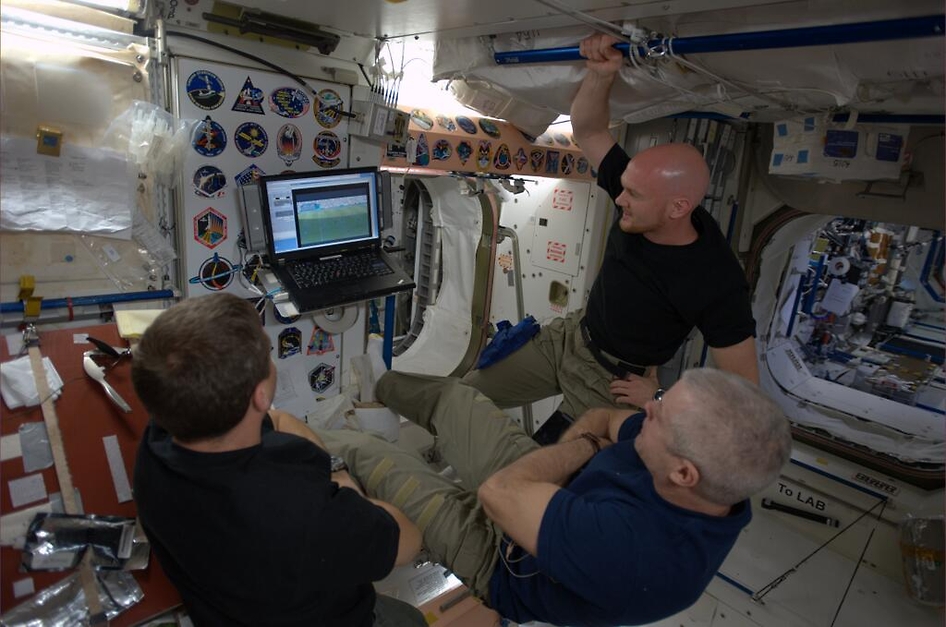|
|
Forthcoming Dates
The Astronomy weekend at Butjani is on Friday 18th July 2014 and Saturday 19th July 2014
Shooting Stars at Isandlwana on 26 - 28 September 2014
-----------------------------------------------------------------------------------------
Astronauts Watch the World Cup Aboard the International Space Station
06/17/2014

NASA astronauts Reid Wiseman, Steve Swanson and ESA astronaut Alexander Gerst take a break to watch ten minutes of live World Cup matches between science experiments while living and working aboard the International Space Station. At the start of the World Cup, the crew sent down a special message to wish good luck to all the players and teams as they compete in World Cup 2014 in Brazil until the final match July 13. The astronauts have trained for years to work together as a unified crew, but the U.S. astronauts and their German crewmate are feeling a little friendly competition: their home countries will play against each other for a chance to advance out of Group G of the World Cup matches. USA and Germany face off on June 26 at Arena Pernambuco in Recife, Brazil. Image Credit: NASA
Orion Crew Module Set for Connection to Heat Shield
05/29/2014

At the Operations and Checkout Building at NASA's Kennedy Space Center, the Orion crew module and heat shield are being moved into position for the mating operation. The heat shield will be tested on Orion's first flight in December, Exploration Flight Test-1 (EFT-1), an uncrewed flight that will put to the test the spacecraft that will send astronauts to an asteroid and eventually Mars on future missions. EFT-1 will launch an uncrewed Orion capsule 3,600 miles into space for a four-hour mission to test several of its most critical systems. After making two orbits, Orion will return to Earth at almost 20,000 miles per hour and endure temperatures near 4,000 degrees Fahrenheit, before its parachutes slow it down for a landing in the Pacific Ocean. Image Credit: NASA
Orion Heat Shield
05/30/2014

The world’s largest heat shield, measuring 16.5 feet in diameter, has been successfully attached to the Orion spacecraft. The heat shield is made from a single seamless piece of Avcoat ablator. It will be tested on Orion’s first flight in December 2014 as it protects the spacecraft from temperatures reaching 4000 degrees Fahrenheit. The uncrewed flight, dubbed Exploration Flight Test-1(EFT-1), will test the spacecraft for eventual missions that will send astronauts to an asteroid and eventually Mars. EFT-1 will launch an uncrewed Orion capsule 3,600 miles into space for a four-hour mission to test several of its most critical systems. After making two orbits, Orion will return to Earth at almost 20,000 miles per hour, before its parachutes slow it down for a landing in the Pacific Ocean.
Gored of the Rings
06/09/2014

Prometheus is caught in the act of creating gores and streamers in the F ring. Scientists believe that Prometheus and its partner-moon Pandora are responsible for much of the structure in the F ring. The orbit of Prometheus (53 miles, or 86 kilometers across) regularly brings it into the F ring. When this happens, it creates gores, or channels, in the ring where it entered. Prometheus then draws ring material with it as it exits the ring, leaving streamers in its wake. This process creates the pattern of structures seen in this image. This process is described in detail, along with a movie of Prometheus creating one of the streamer/channel features, in PIA08397. This view looks toward the sunlit side of the rings from about 8.6 degrees above the ringplane. The image was taken in visible light with the Cassini spacecraft narrow-angle camera on Feb. 11, 2014. The view was acquired at a distance of approximately 1.3 million miles (2.1 million kilometers) from Saturn and at a Sun-Saturn-spacecraft, or phase, angle of 147 degrees. Image scale is 8 miles (13 kilometers) per pixel. The Cassini-Huygens mission is a cooperative project of NASA, the European Space Agency and the Italian Space Agency. The Jet Propulsion Laboratory, a division of the California Institute of Technology in Pasadena, manages the mission for NASA's Science Mission Directorate, Washington, D.C. The Cassini orbiter and its two onboard cameras were designed, developed and assembled at JPL. The imaging operations center is based at the Space Science Institute in Boulder, Colo. For more information about the Cassini-Huygens mission visit http://www.nasa.gov/cassini and http://saturn.jpl.nasa.gov. The Cassini imaging team homepage is at http://ciclops.org . Image Credit: NASA/JPL-Caltech/Space Science Institute
|

